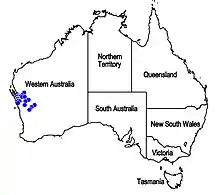Dicrastylis linearifolia
Dicrastylis linearifolia is a species of plant within the genus, Dicrastylis, in the family Lamiaceae.[4] It is endemic to Western Australia.[4]
| Dicrastylis linearifolia | |
|---|---|
| Scientific classification | |
| Kingdom: | Plantae |
| Clade: | Tracheophytes |
| Clade: | Angiosperms |
| Clade: | Eudicots |
| Clade: | Asterids |
| Order: | Lamiales |
| Family: | Lamiaceae |
| Genus: | Dicrastylis |
| Species: | D. linearifolia |
| Binomial name | |
| Dicrastylis linearifolia | |
 | |
Description
Dicrastylis linearifolia is a many branched shrub, growing from 1 m to 3 m high, on red sands, on sandplains. Its stems are roughly circular in cross section, and have no peltate scales. The opposite and entire leaves are 15-40 mm long by 2-6 mm wide, whose upper surfaces have branched (dendritic) hairs. There are no bracteoles, but there are bracts which are 0.7-1. mm long. The flower stalks are 2.5-3.5 mm long, and have dendritic hairs, and peltate scale hairs. The calyx has five lobes (1-1.7 mm long), and is covered in dendritic hairs, and the white to cream corolla is 4.5-6.5 mm long, with no dots or stripes in its throat. There are five stamens. Flowers may be seen from November to December.[1]
It is found in Beard's Eremaean and South-West Provinces.[1]
Taxonomy
It was first described by Ahmad Abid Munir in 1978 as Dicrastylis linearifolia.[2][3] There are no synonyms.[4]
References
- "Dicrastylis linearifolia". FloraBase. Western Australian Government Department of Parks and Wildlife. Retrieved 23 November 2020.
- "Dicrastylis linearifolia". Australian Plant Name Index (APNI), IBIS database. Centre for Plant Biodiversity Research, Australian Government. Retrieved 23 November 2020.
- Munir, A.A. (1978). "Taxonomic revision of Chloanthaceae trib. Physopsideae". Brunonia. 1 (4): 468–470, Fig. 7, Map 4. doi:10.1071/BRU9780407. ISSN 0313-4245. Wikidata Q55756057.
- Govaerts, R., et. al. "Plants of the World online: Dicrastylis linearifolia Munir". Board of Trustees of the Royal Botanic Gardens, Kew. 2020. Retrieved 23 November 2020.
